Remove the front wheel & tire.
Tightening torque :
90.0 ~ 110.0 N.m (9.0 ~ 10.0 kgf.m, 65.0 ~ 80.0 lb-ft)

Raise the rear of the vehicle and make sure it is securely supported. Remove the rear wheel.
Remove the front wheel & tire.
Tightening torque :
90.0 ~ 110.0 N.m (9.0 ~ 10.0 kgf.m, 65.0 ~ 80.0 lb-ft)

Remove the brake hose bolt (B) and the guide rod bolts (C) from the caliper assembly (A).
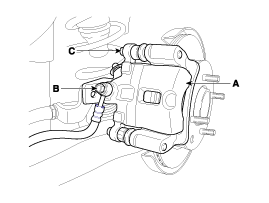
Remove the rear caliper body (A).
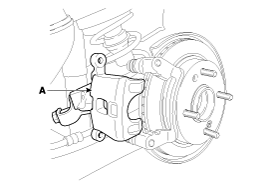
Remove the pads (B), the pad springs (C) from the caliper carrier (A).
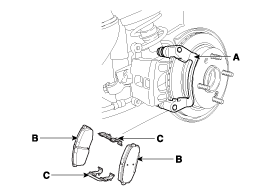
Remove the rear caliper (B) and the caliper mounting bolts (A).
Tightening torque :
65.0 ~ 70.0 N.m (6.5 ~ 7.5 kgf.m, 47.0 ~ 54.2 lb-ft)

Remove the brake disc (A) and the screw (B).
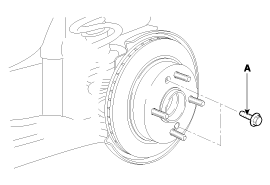
Frequent inhalation of brake pad dust, regardless of material composition, could be hazardous to your health.
Avoid breathing dust particles.
Never use on air hose or brush to clean brake assemblies.
Loosen the guide rod bolt and then remove the rear caliper body (A).

Remove the pads (B), the pad springs (C) from the caliper carrier (A).

Remove all rust and contamination from the disc surface, and then measure the disc thickness at 8 positions at least.
Rear brake disc thickness
Standard value : 10.0 mm (0.39 in)
Limit : 8.4 mm ( 0.33 in)
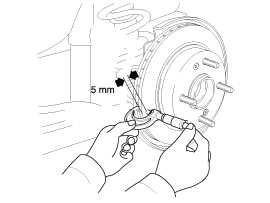
Thickness variation should not exceed 0.01 mm (0.0004in) (circumference) and 0.01 mm(0.0004 in) (radius) at any directions.
If wear exceeds the limit, replace the discs and pad assemblies for left and right of the vehicle.
Check the pad wear. Measure the pad thickness. replace it if it is less than the specified value.
Pad thickness
Standard value : 10.0 mm (0.39 in)
limit : 8.0 mm (3.14 in)
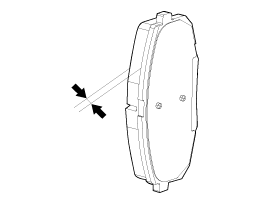
Check that grease is applied, to sliding contact points and the pad and backing metal for damage.
Install the brake disc (A) and tighten the screw (B).
Tightening torque :
4.9 ~ 5.9 N.m (0.5 ~ 0.6 kgf.m, 3.6 ~ 4.3 lb-ft)

Install the rear caliper (B) and tighten the caliper mounting bolts (A).
Tightening torque :
65.0 ~ 70.0 N.m (6.5 ~ 7.5 kgf.m, 47.0 ~ 54.2 lb-ft)

Install the pads (B), the pad springs (C) from the caliper carrier (A).

Check the foreign material at the pad shims and the back of the pads.
Contaminated brake discs or pads reduce stopping ability. Keep grease off the discs and pads.
Push in the piston using the SST (09581-11000) so that the caliper will fit over the pads. Make sure that the piston boot is in position to prevent damaging it when installing the caliper.
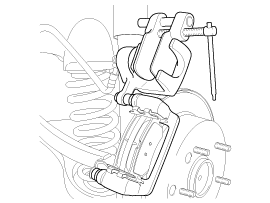
Install the caliper body (A).
Be careful not to damage the piston pin boot.
Install the brake hose bolt (B) and the guide rod bolts (C) to the caliper assembly (A).

Refill the master cylinder reservoir to the MAX line.
Bleed the brake system.
(Refer to Brake System - "Bleeding of Brake System")